Gwangjang Market: How To Get There & What To Eat
Last Updated on May 19, 2024
Gwangjang Market (광장시장) is one of the largest traditional markets in Korea and was even featured on Netflix’s Chef’s Table. If you’re in the city for any amount of time and looking for one of the best places to eat in Seoul, this is a must visit.
Gwangjang traditional market is a well known market for fabric and Hanboks, but it’s also known for eats eats eats and it’s not just visited by tourists, but locals frequent Gwangjang Market, too. The market is one of my top recommendations for tourists, visitors, friends, and family when it comes to where to eat in Seoul. I just love it… and here’s why…
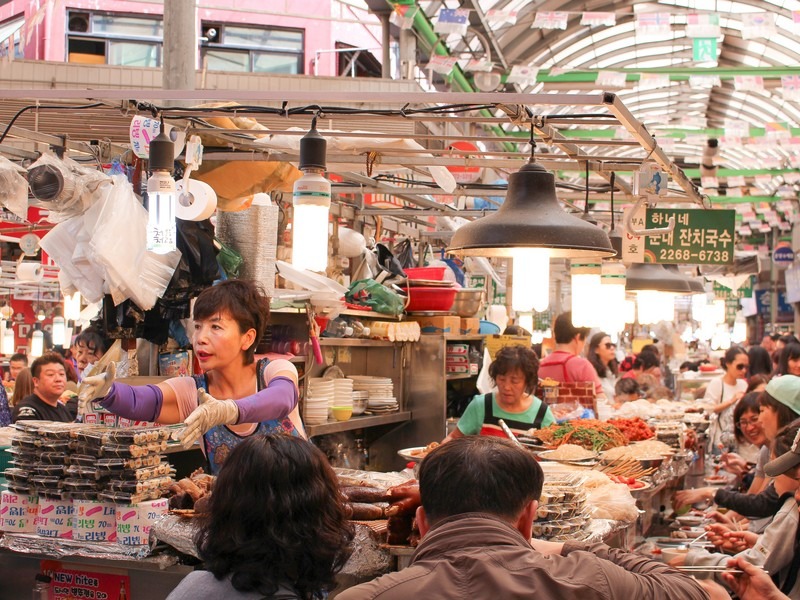
Gwangjang Market is a must visit whether you’re visiting or living in Seoul. Do NOT miss this traditional market in Seoul and the good eats there.
- How To Get There
- Basic Information
- The History
- What To Expect
- What To Eat
- Side Dishes and Jesa Food Too!
(This page contains affiliate links. That means if you click on them and purchase something, I will get a percentage of the transaction at no cost to you. Thanks for the support!)
How To Get There
Address: 88 Changgyeonggung-ro, Jongno-gu, Seoul (서울특별시 종로구 창경궁로 88 (예지동))
Directions: Go out of Jongno 5-ga Station, exit 7. Walk straight and an entrance will open up on your right. OR Euljiro 4-ga Station, exit 4. Walk straight, cross over the Cheonggyecheon Stream and an entrance will open up on your right.
Basic Information
Hours: Stores: 8:30am ~ 6:00pm; Restaurants: 8:30am ~ 11:00pm
Days: Restaurants and vintage clothing section open every day; Fabric vendors/Hanbok vendors closed Sundays.
Amenities: Parking, restrooms
Website: www.kwangjangmarket.co.kr
The History
Gwangjang Market was opened in 1905 in Seoul, Korea and at the time, markets weren’t permanent but were temporary, opening for just a few days here and there. Gwangjang Market was the first to be permanently established and was open every day. There are other traditional Korean markets in Seoul, and whatever district you’re in, they’re great for a bite to eat.
Gwangjang Market is the oldest traditional market in Seoul, Korea. The market, like many downtown, is known for one kind of product, and that is the fabric it sells. From fabric for curtains, pants and suits to Hanboks (I purchased my first Hanbok here with my mother-in-law), bedding and linen, it’s all in Gwangjang Market.
The small alleyways are strewn with stores where one can be measured to have a suit made or head upstairs to get a Hanbok. The market is known for having quality goods at affordable prices. From buttons to thread and zippers to bobbins, it’s all there. This is unsurprising considering it’s sitting in one of the most fashion driven areas in Seoul.
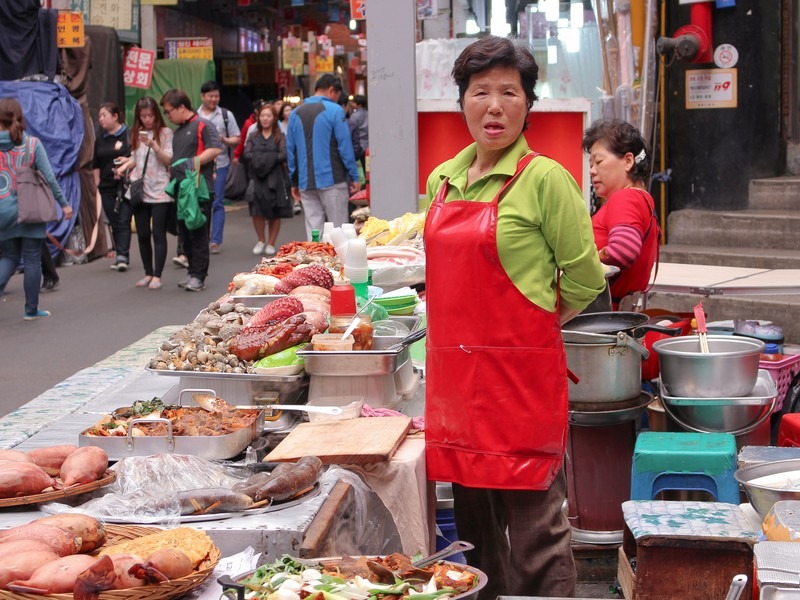
If you’re looking for vintage clothing in Seoul, this is also a big reason to visit Gwangjang Market. While most of the upstairs is filled with Hanboks, there’s also a substantial vintage market upstairs drawing crowds of young people due to the cheap cost but great items available. While this market is famous for it’s fabrics and clothing goods, it has become just as popular for the food sold downstairs.
With so many workers and vendors in the market, it stands to reason they needed something to eat throughout the day so food vendors popped up and now they’re a big draw for the tourists and locals in the area. Gwangjang Market (광장시장) is not an unpopular market to visit, though it’s still relatively difficult to order if you don’t speak Korean and have questions about what you’re ordering. Most of the stalls have menus with multiple languages that will give you a basic understanding of dishes though.
What To Expect
While the vendors welcome everyone, and they do so loudly as they usher you to take a seat, they speak very little English. They do however speak a bit more Mandarin and Japanese so if you’ve got those under your belt, have some fun.
The vendors are usually moving pretty quickly and what you see is what you get.. meaning, the food in front of you is exactly what they’re serving. So, if you can’t read any signs, just point and you’ll end up with something in front of you to sup on. The food is delicious and is one of my top five places I suggest to family and friends who are stopping through for just a short time.
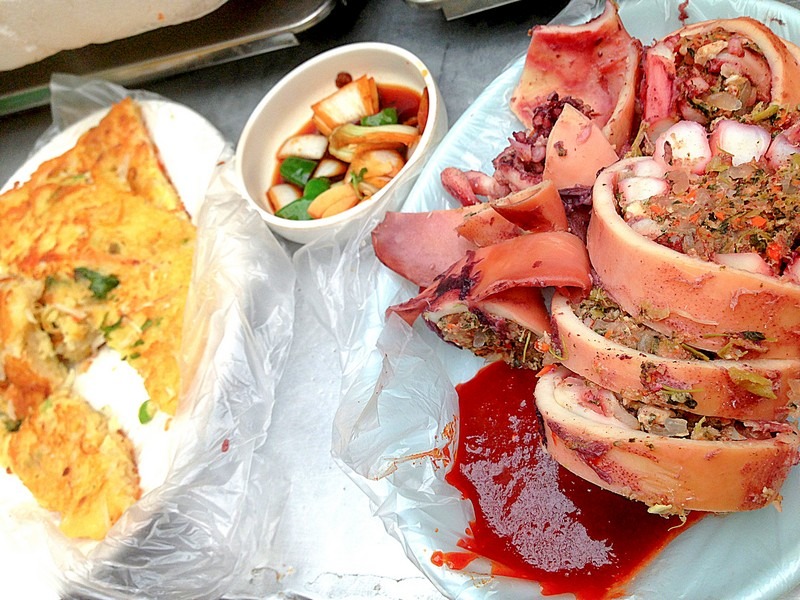
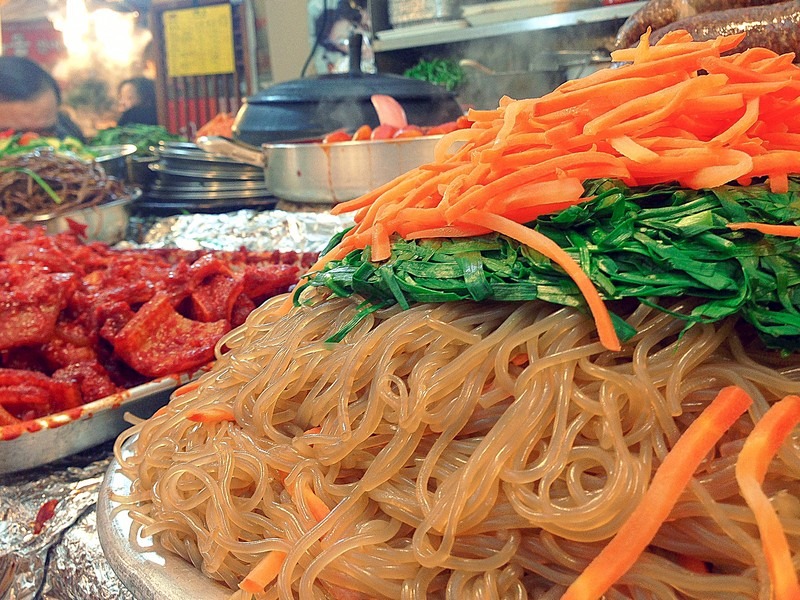
The vendors in the market sell not only dishes ready to be eaten, but they also have fresh produce, seafood and Korean side dishes that patrons can purchase to take home with them. These days, due to the influx in tourists to the area, the vendors selling side dishes also provide toothpicks so that you can sample some of the side dishes they sell. Try the little stir-fried crabs, they’re a personal favorite. You just stick the whole thing in your mouth and chew away. Yum!
What To Eat
There is a great variety of food options at Gwangjang Market so whether you’re an adventurous eater or not quite prepared to dive right in to the traditional market fare, there is something for everyone. On top of that, there are also vegetarian options if someone in your group doesn’t eat meat.
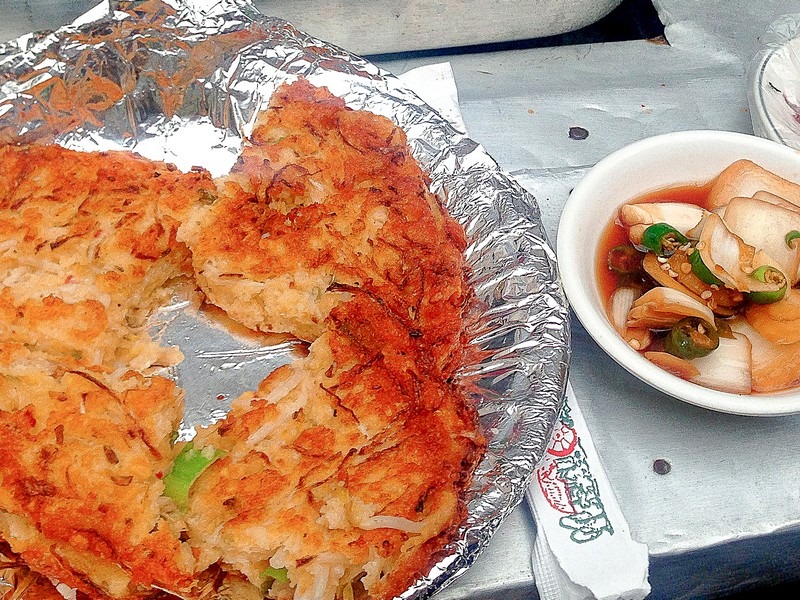
Bindaetteok (빈대떡)
At the central hub of the food stalls in the market, you’ll notice a few very popular vendors whipping up something on a griddle. These are mung bean pancakes. They’re a bit like potato pancakes so if you have a picky eater, they’ll mostly likely love these. They’re really easy to eat.
While there is a little seat nearby where you can sit and eat these, we usually stop here first, grab some bindaetteok to-go and then sit at a kalguksu stall to eat the noodles and this at the same time. If you’re into stall hopping then bounce around, but you can take them to-go too.
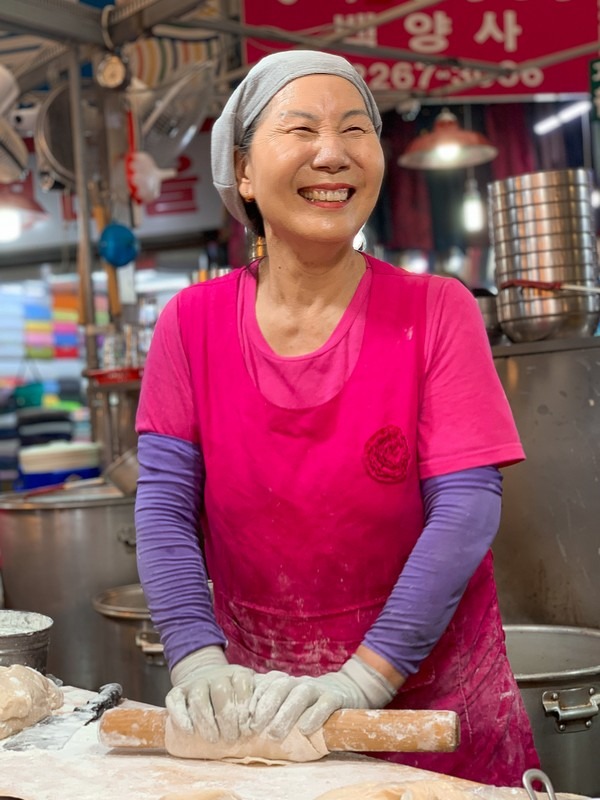
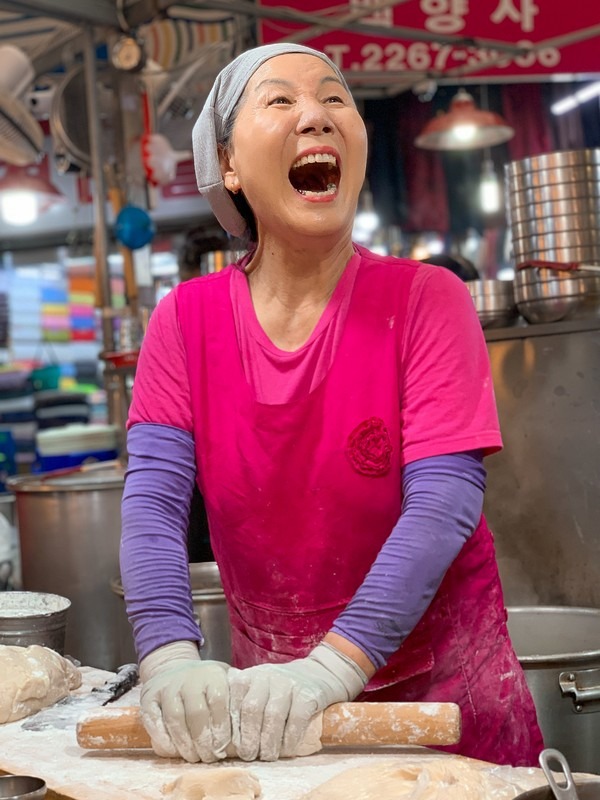
Kalguksu (갈국수)
I just mentioned that we usually take our bindaetteok to go and sit at the kalguksu stall to eat it together with our noodle soup and we usually head to the most popular kalguksu vendor in the place. Featured on Netflix, you’ll quickly recognize the lovely woman that is serving up this dish. Kalguksu is knife-cut Korean style handmade noodles. The soup is hot and delicious and with a vegetable broth, it’s easy for everyone to eat including your vegetarian friends.
The soup is a pretty substantial dish and we usually split one bowl between two people.. especially if you want to try food at other stalls. Don’t be surprised if you have to wait to eat with the Netflix Lady, her stall was always popular, but now it’s even more popular and seeing a line is not uncommon. It’s worth it though.

Mandu (만두)
From kimchi stuffed mandu that may be a bit spicy for some to tofu and pork stuffed mandu, these are usually a great addition to your dishes. We usually get mandu, or dumplings, with our kalguksu. She has delicious options but quite a few stalls nearby have some great dumplings too. The Netflix lady has some fantastic kimchi dumplings if I do say so though. There are also stalls that serve dumpling soup as well if you want it in a warmer and cozier version.
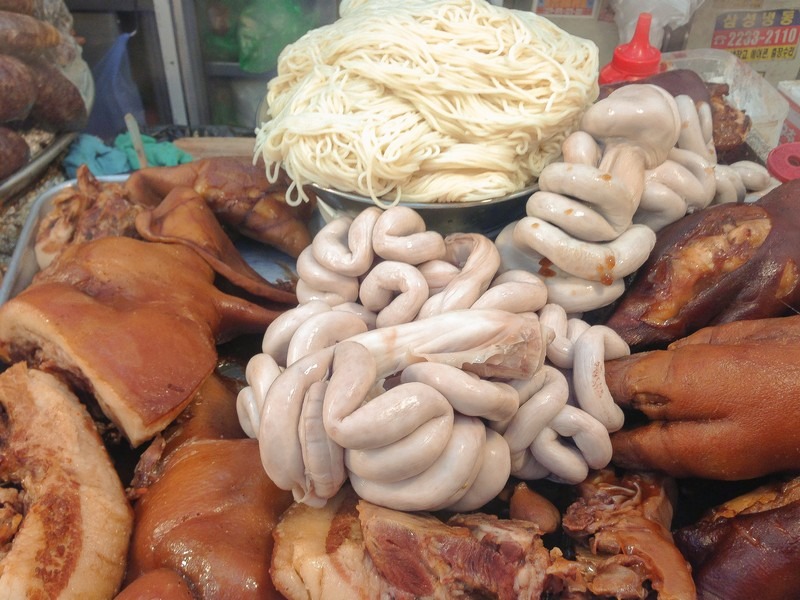
Sundae (순대)
Sundae are often translated to pig’s intestines. They’re similar to blood sausages and tend to be for the more adventurous eaters in your group, though I’ll tell you, they’re not adventurous as you really think. They’re sausages stuffed with glass noodles and are more noodles than anything else. You dip them in a little salt and they’re very savory and delicious.
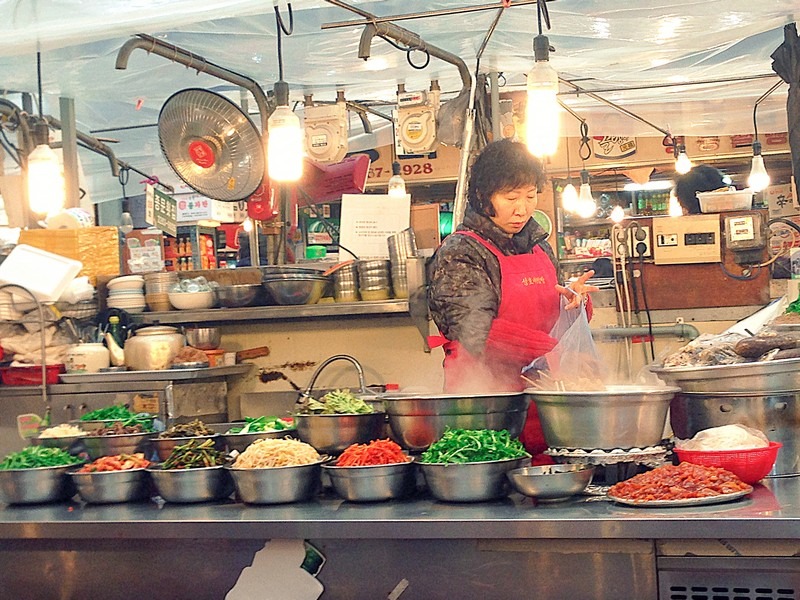
Bimbimbap (비빔밥)
You probably had some version of this on your flight over to Korea but trust me, the airplane version doesn’t really do the dish justice. At some of the stalls, you’ll notice bowls and bowls of deliciously fresh looking vegetables piled high. It is here that you can get bibimbap. Bibimbap is a variety of vegetables on a bed of rice with red pepper sauce.
Even if you’re not sure about eating in this traditional market, you should definitely stop by to see the hustle and bustle and just take some awesome photos of Korean food as it moves quickly from shelves to platters and into mouths. This market is my favorite for the cuisine but also for the ambiance that is always exciting and full of energy.
You can also get bibimbap easily and quickly at any local Kimbap Cheonguk. It’s a great option for anytime you need a good filling veggie filled meal.
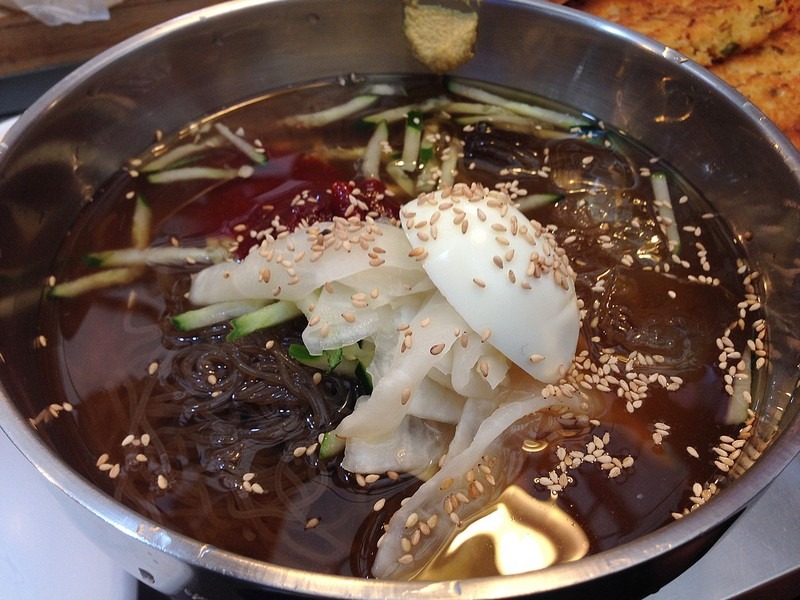
Mul-naengmyeon (물냉면)
If it’s the hottest point in summer and eating a boiling kalguksu noodle dish isn’t calling you, this is the best option for you. Mul-naengmyeon is a cold noodle broth soup. Yes, there’s actually ice cubes in the soup! The buckwheat noodles are topped with radish, cucumbers and a hard-boiled egg. There is some wasabi on the side as well as the red-pepper paste in the bowl.
When first received, you should take your chop sticks place them in the center of the noodles and spread them out, this way and that sort of kneading everything around and inside in order to mix thoroughly and then taste. Also, don’t be surprised if vendors cut your noodles up with a pair of scissors because buckwheat noodles can be a bit chewy, so you either slurp them all up in one go, or get them cut up a bit.
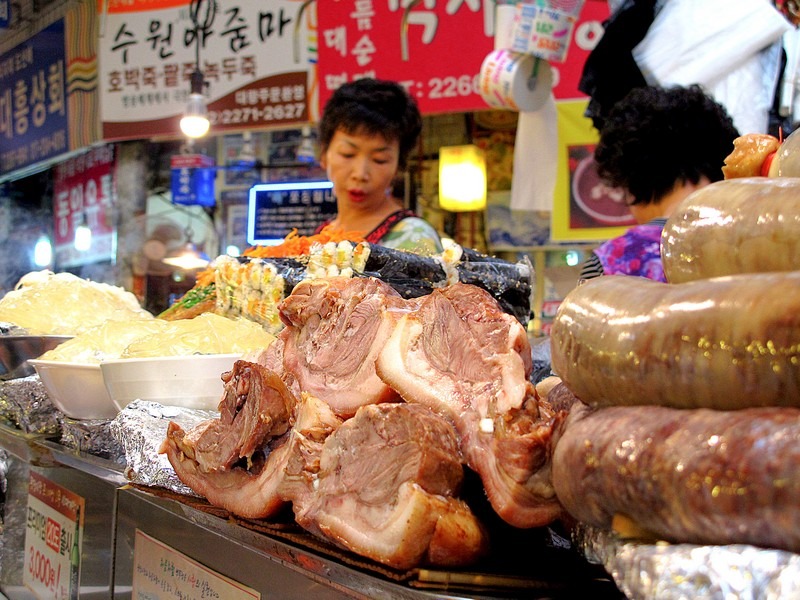
Jokbal (족발)
So you’re getting more adventurous and looking closer, you start to notice feet… jokbal is pigs trotters or pigs feet. These pigs feet are boiled for hours in a stock made of water, sugar, soy sauce, garlic, ginger, rice wine, and maybe a secret ingredient depending on where it’s from.
Most vendors keep them whole when you see them on the shelves, but once ordered, they will be sliced up and served. The meat is tender and is great if you’re looking for something meaty, fatty and extremely mouth watering.
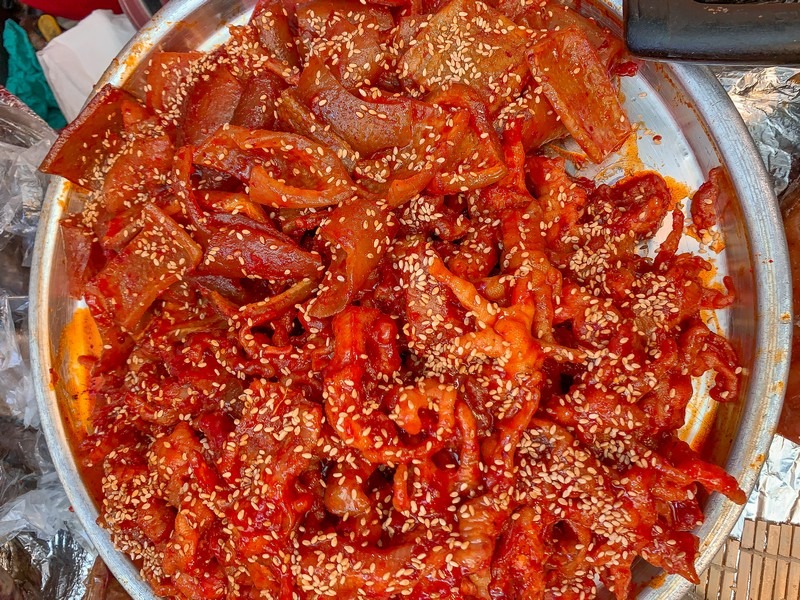
Dalkbal (닭발)
We’re not quite done with the feet options at Gwangjang Market. Dalkbal is chicken feet and is made with a spicy red pepper sauce and if you’re lucky they have already been de-boned. All of the places in Gwangjang Market serve them de-boned luckily. The skin and tendons that make up the feet make the bite a bit crunchy while at the same time squishy. If you don’t like strange consistencies in your mouth, this probably isn’t the dish for you.
Chicken feet wouldn’t be the main dish of a meal but would be a dish eaten while drinking alcohol, often makgeolli or rice wine. It’d be like eating spicy chicken wings in the States. The spicy sauce on the feet makes them perfect for that bite between drinks with friends.
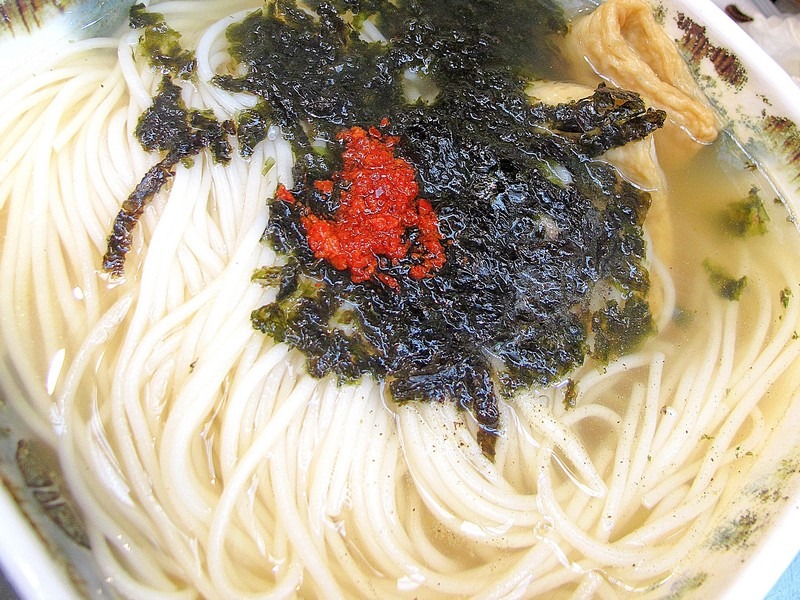
Janchiguksu (잔치국수)
If you’re looking to order something adventurous but one something simple on the side or maybe you don’t want a giant kalguksu meal, then there’s the delicious and comforting janchiguksu.
This soup is often eaten in Korean homes while also common at wedding buffets and other major events. It’s a warm and light soup that fills you up without weighing you down. It is one of my all time favorites that I could eat anytime. It’s a pretty straightforward noodle soup with fish broth and some vegetables to top it off. My daughter loves this. It’s great for kids.
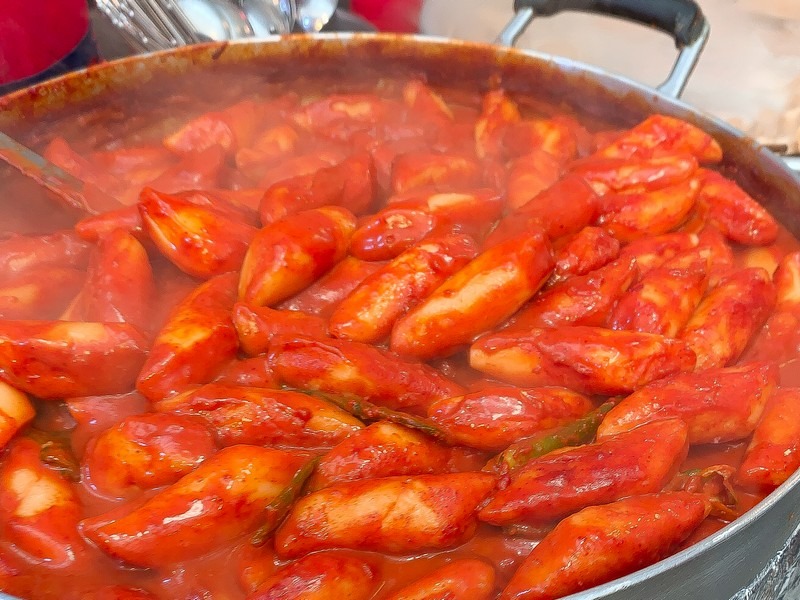
Tteokbokki (떡볶이)
Easily recognizable, this Korean street food called tteokbokki is all over. Sticky dense rice rolls are stewed in a thick red pepper sauce and they are spicy! They’ll be served hot from the simmering pan. Koreans call it a snack, I call it a meal. Usually, you’ll order a dish of tteokbokki along with a dish of sundae. They go together really well.
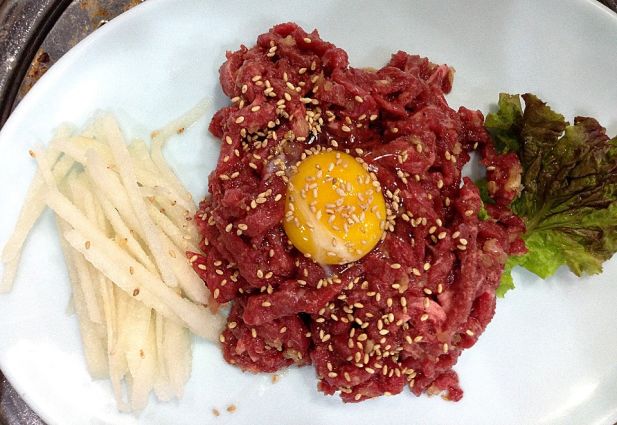
Yuk-hoe (육회)
The market can be a little bit difficult to navigate because there are a couple main thoroughfares but then every nook and cranny and tiny alley is also filled with restaurants and vendors too. Down one tiny walkway that branches off of the larger market pathway is a collection of restaurants serving up yuk-hoe (육회) or steak tartare.
Yuk means meat and hoe means sashimi. A tender cut of beef is thinly sliced and often mixed with a marinate of soy sauce, garlic, sugar, sesame oil, salt and pepper. It’s served on a platter with the raw egg on top and some thinly sliced Korean pear. Once on the table one person will mix this all together into a rather sloppy mess, it looks much more pleasant before it’s mixed together, and then diners dig in. Yuk-hoe is one of the most popular dishes at Gwangjang Market. It’s delicious!
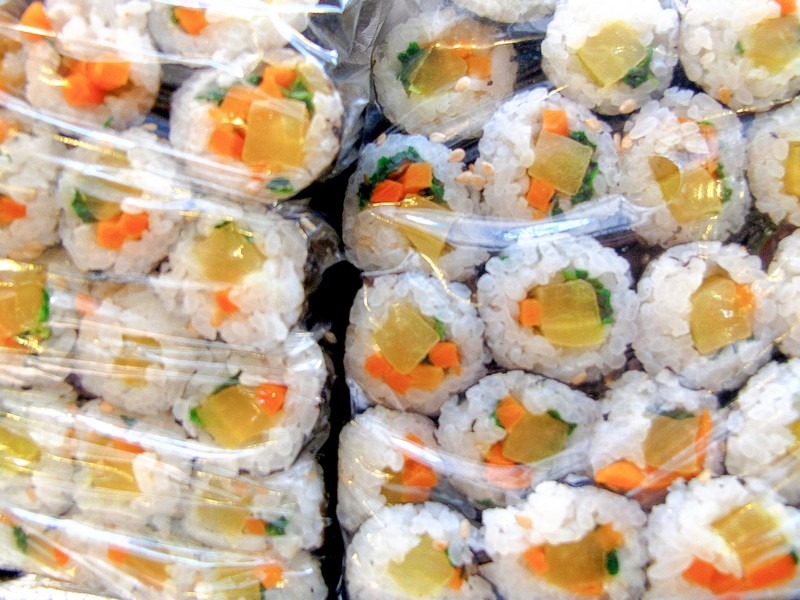
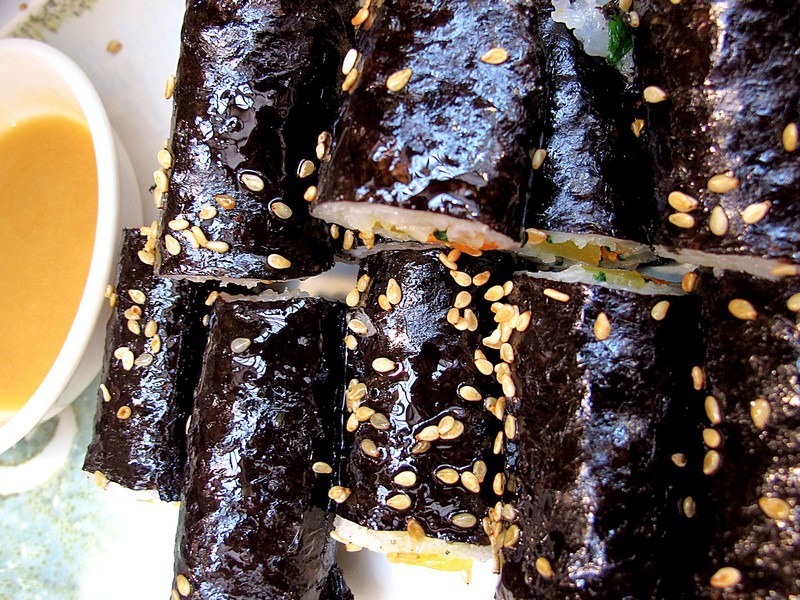
Gimbap (김밥)
One very popular dish at the market is the gimbap. It looks like sushi, but the Korean version doesn’t have raw fish.
At Gwangjang Market, the most pouplar kimbab is served from Mayak Kimbap which is located in the central hub of the food stalls just on the corner. These gimbaps are smaller than the standard ones you see outside. I usually don’t eat them in the market, but take these to go.
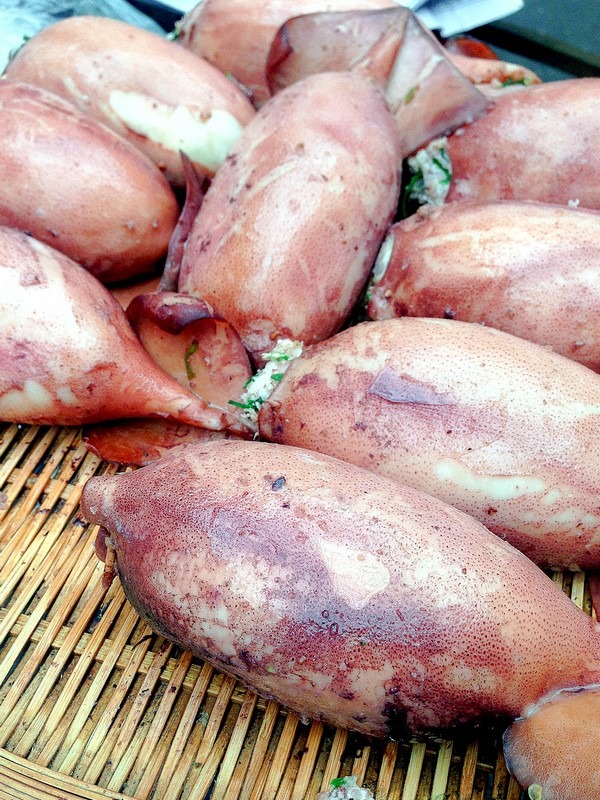
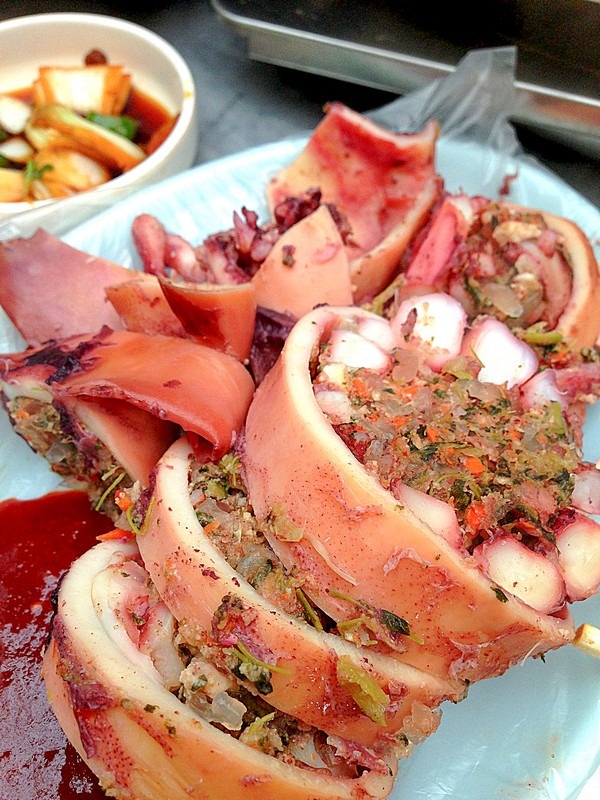
Ojingeo Sundae (오징어 순대)
Another dish that is a standout and a real treat is the ojingeo sundae, or stuffed squid. The squid is stuffed with a variety of veggies and glass noodles. There is a sweet and spicy red sauce to dip it in and then the hard part is eating it.
Ideally the whole piece should be taken in all at once, but they are HUGE! The vendor that sells this is a bit away from the regular vendors down near the vintage clothing section and they only seem to set up in the early evenings and weekends so they may or may not be there when you go.
Sannakji (산낙지)
One dish that has started being offered at more stalls due to tourist frequency is sannakji, or live octopus. The octopus is cut fresh and still moving when it’s served and you dip it in a sesame oil and salt sauce before eating.
To be honest, it’s not really a dish I’d recommend eating here. It’s only here because tourists like to see it move before they eat it but it’s better enjoyed at one of the fresh fish markets in the city.

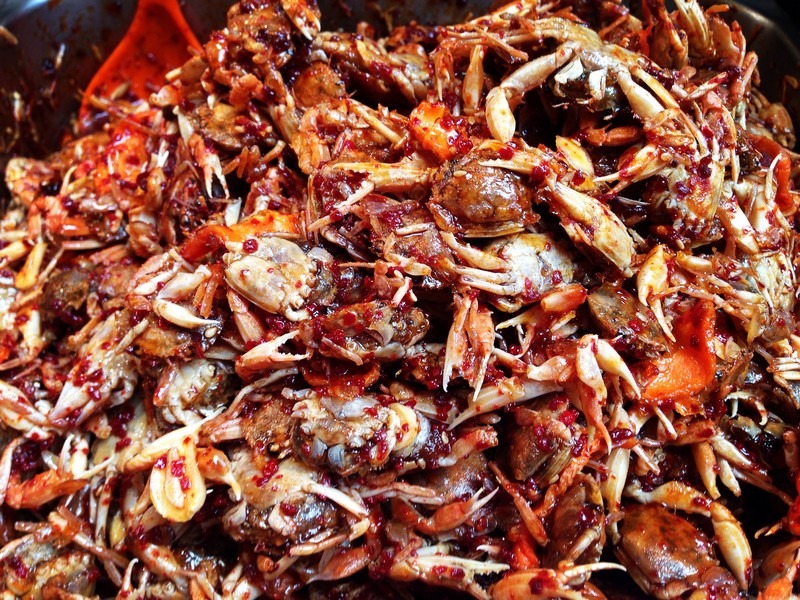
Side Dishes and Jesa Food Too!
Gwangjang Market is also just a food market with aisles of vendors that have Korean side dishes, Korean teas, and sets to purchase for a Korean dol and other ceremonies like the Korean jesa which is done on major Korean holidays like Chuseok, the Korean thanksgiving, and Seollal, the Lunar New Year. If you’re prepping for those holidays, definitely visit Gwangjang Market.
I think you’re pretty prepared for a trip to Gwangjang Market now. Enjoy the trip and eat all the things!
Did you like this post? Pin IT!
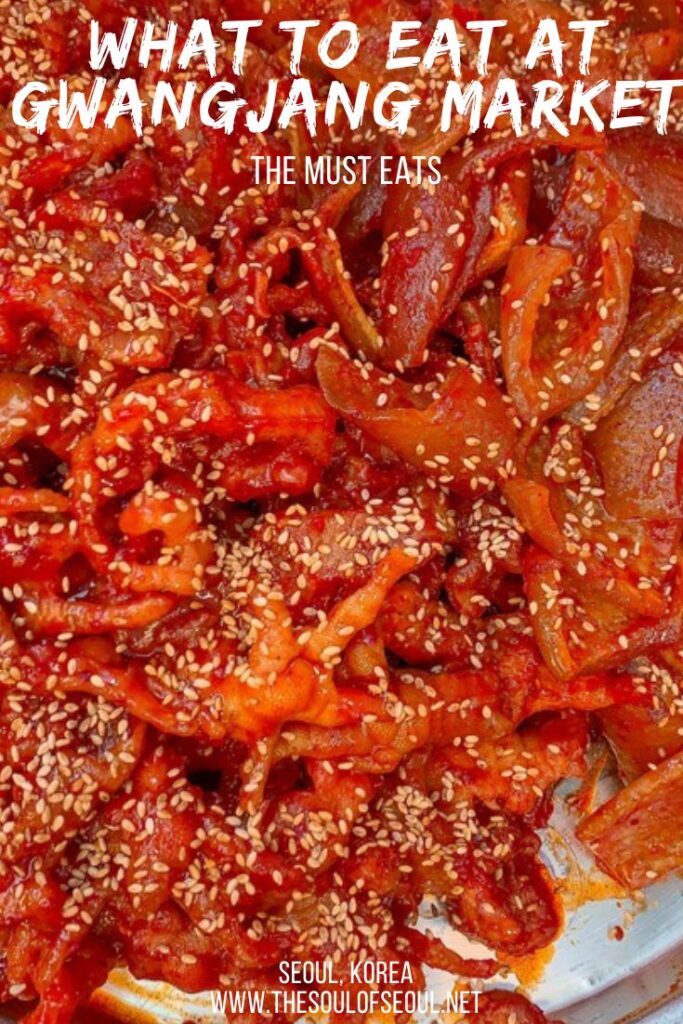
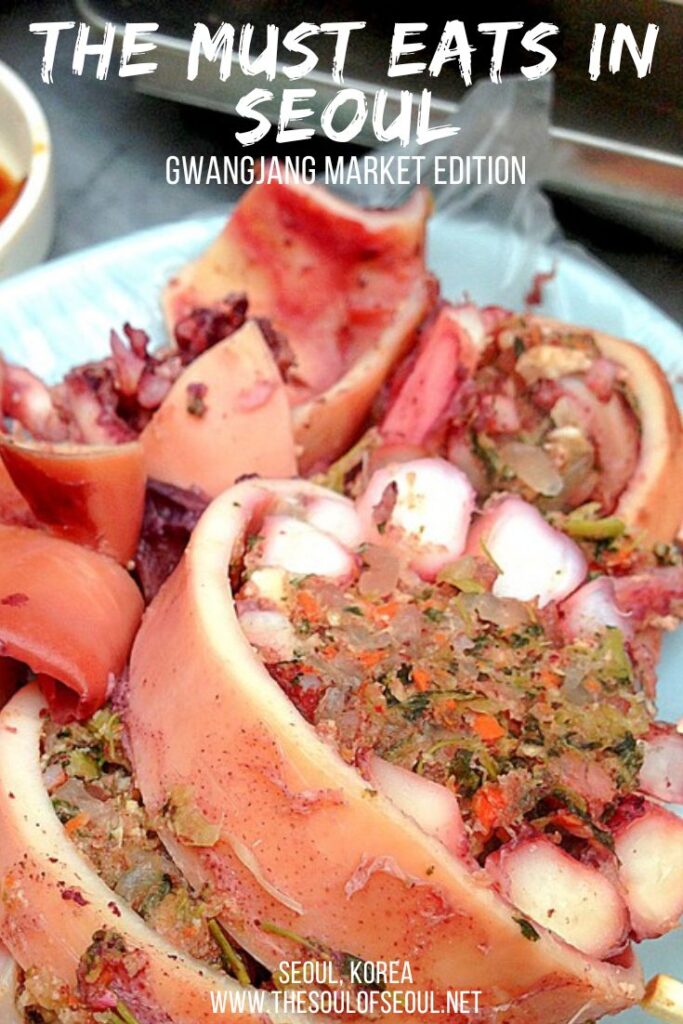
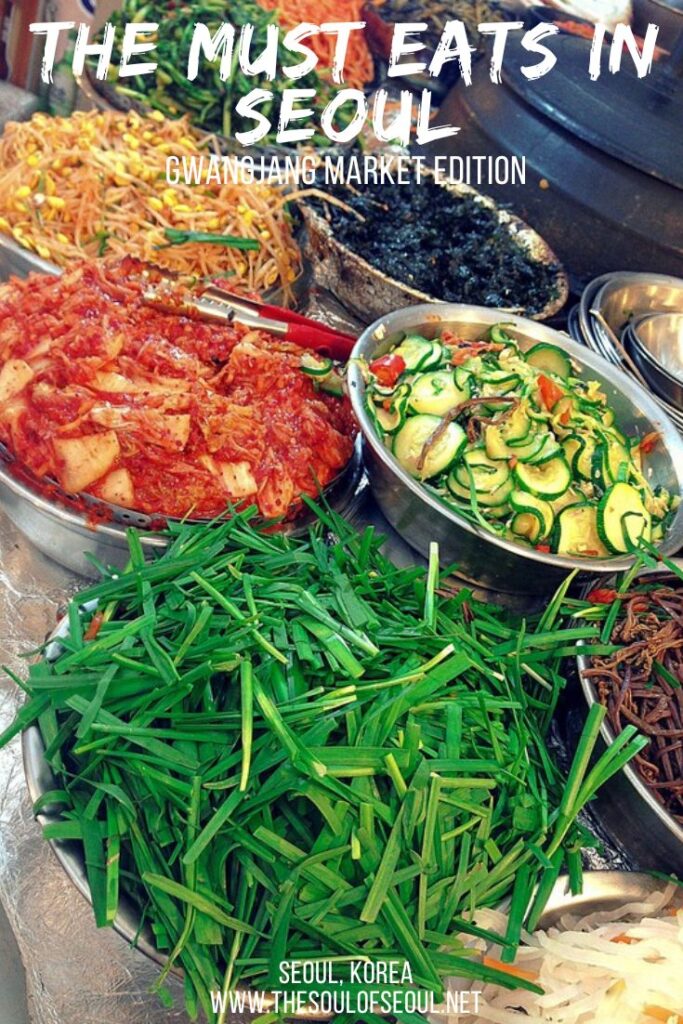
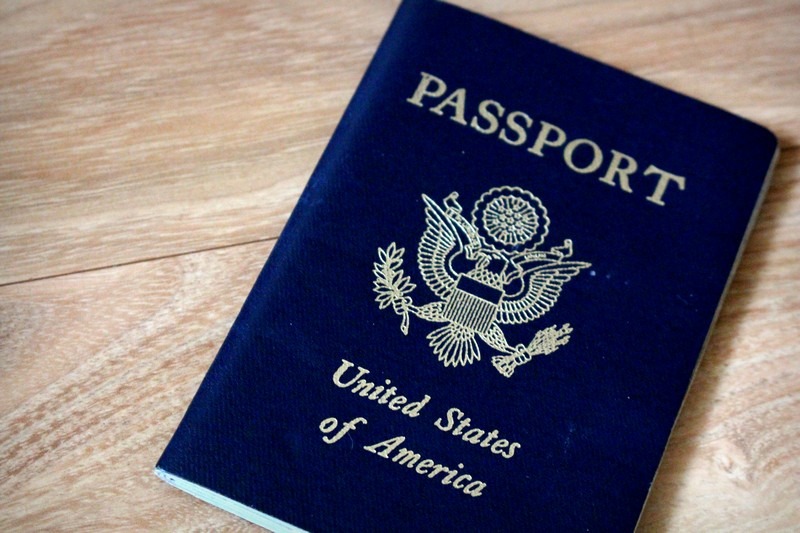

11 Comments
Shahana Islam
Your blog is amazing and so informative! I’ve read soooo many of your articles/posts. For Gwangjang Market, what time would you recommend is best with a 3.5 year old? We will not have a stroller. Is 9am too early? Or would a weekday lunch be okay?
Hallie Bradley
The market opens that early, but I’m not sure if the food stalls would all be ready for service at that time. I’ve been there at 10:00am though and had early lunch and found enough. It’s bustling weekend and weekday, but personally, I find going around the 10:00am time to be ideal and with less crowds. Go at 9:00am and see what happens. Could be even better. If it’s a bit too early, just go to the southern side and walk along the Cheonggyecheon stream for a bit til more opens.
Shahana Islam
Thank you so much!
Nneka
Hello! Your blog is very informative especially for a first time traveller like me. I’ve been doing a lot of research to get ready for my trip, and your blogs has been very helpful. Gwangjang Market is one of the places I’m planning to visit, and I just want to ask, would you happen to know the operating hours for the Kalguksu Netflix lady’s stall?
Hallie Bradley
I’m not exactly sure about her stall, but she’s been open when I’ve visited as early as 10:00am and as late as 6:00pm on various days of the week. She’s quite popular, so I’m sure she’s there and open just about every day.
Tamar Lipszyc
Hi
first of all your site is Excellent! thanks for that. I wonder do they have any vegeterian/vegan food in this market?
Hallie Bradley
They do. If you don’t speak Korean, it’s good to get something written out to ask for the vegetarian options when you’re visiting. But, the stall I always go to has vegetarian noodle soups and dumplings. If you watched the Netflix show that stopped in Gwangjang Market, the woman I mention above in the article, she has veg options. I believe the bindaeddeok is vegetarian too being made out of bean sprouts, but you’d want to ask just to make sure.
Star Lengas
This looks absolutely yum-tastic! 1. I love food, 2. Jokbal is amazing, although seeing the pig feet freaks me out haha. I definitely need to explore Gwangjang market! Sounds like a perfect weekend activity.
Hallie
It is, though definitely go a bit earlier if you can because the weekend can be intense there. It’s fun to see it intense, but it’s NOT fun to find a place to sit… head in around 10:00/10:30 and you’ll be able to find a place to eat but also see as all the peeps come for lunch and start to fill it up. And make sure to go upstairs, there’s a massive Hanbok market which is beautiful but at the furthest northeast corner upstairs, there’s a vintage market which is awesome too. A lot of great finds up there.
Daphne from Girlswanderlust
Seems like a great place to visit. The pictures of the food look amazing and for some dishes it would be a challenge to eat haha. Would love to visit Gwangjang Market one day. Thanks for sharing info about this place!
Hallie
Yes, some can be a challenge. But it’s mind over anything ya know. When I take people there, I usually start with something a bit easier to stomach and work our way up. Great place to visit for authentic and delicious Korean foood. ^^